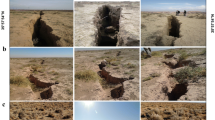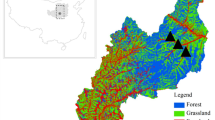Abstract
Aims
Soil water deficits have presented challenges to vegetation restoration in rocky desertification areas. In the field, small volumes of soil resources are present only in near-surface crevices, fissures, and other similar features. Water stored in the soil in near-surface fissures can help plants grow in such areas. The goals of this study are to discuss the soil water retention functions of near-surface fissures in terms of soil structure, water infiltration and water storage capacity and to define the role of fissure water in the growth of plants in rocky desertification areas.
Methods
Several near-surface fissures with four types of vegetation (i.e., crops, grass, shrubs and trees) within a rocky karst desertification area on the Karst Plateau in Guizhou Province, China, were examined. Soil physicochemical property analysis and stable isotope techniques were applied.
Results
Fissures with shrubs and trees present high levels of soil porosity, while fissures with crops and grasses present low levels of soil porosity. The water infiltration rates of the soil in all of the examined fissures are higher than the rainfall intensity of the maximum daily rainfall for this province. Consequently, most rainwater infiltrates through the fissure soils. Compared to the other fissures, fissures with crops present higher levels of usable soil storage capacity in the surface soils (0–20 cm), which are affected by tillage (ploughing), but exhibit lower capacities in the bottom soil layer. Additionally, tree and shrub fissures present higher usable soil storage capacities in bottom soil layer than other types of fissures.
Conclusions
The main source of water for Ligustrum and Pyracantha in the dry season is fissure water, which accounts for 44.7% and 58.2% of all the water utilized by these species, respectively. Fissure water may represent the most important source of water for plants growing in near-surface karst fissures.






Similar content being viewed by others
References
Bodhinayake W, Si BC, Noborio K (2004) Determination of hydraulic properties in sloping landscapes from tension and double-ring infiltrometers. Vadose Zone J 3(3):964–970
Cao JH, Yuan DX, Pan GX (2003) Some soil features in karst ecosystem. Adv Earth Science 18(1):37–44
Cerdà A (2001) Effects of rock fragment cover on soil infiltration, interrill runoff and erosion. Eur J Soil Sci 52(1):59–68
Chen HS, Liu JW, Wang KL, Zhang W (2011) Spatial distribution of rock fragments on steep hillslopes in karst region of Northwest Guangxi, China. Catena 84(1–2):21–28
Čustović H, Misilo M, Marković M (2014) Water balance of Mediterranean karst soil in Bosnia and Herzegovina as a water conservation and erosion control factor. Soil Sci Plant Nutr 60(1):100–107
Dai Q, Peng X, Zhao L, Shao H, Yang Z (2017) Effects of underground pore fissures on soil Erosion and sediment yield on karst slopes. Land Degrad Dev 28(7):1922–1932
Ehleringer JR, Roden J, Dawson TE (2000) Assessing ecosystem-level water relations through stable isotope ratio analyses. In: Sala OE, Jackson RB, Mooney HA, Howarth RW (eds) Methods in ecosystem science. Springer, New York, pp 181–198
Estrada-Medina H, Graham RC, Allen MF, JJ J’n-O, Robles-Casolco S (2012) The importance of limestone bedrock and dissolution karst features on tree root distribution in northern Yucata’n, Me’xico. Plant Soil 362:37–50
Febles-González JM, Vega-Carreño MB, Tolón-Becerra A, Lastra-Bravo X (2012) Assessment of soil erosion in karst regions of Havana, Cuba. Land Degrad Dev 23:465–474
Fiorillo F (2009) Spring hydrographs as indicators of droughts in a karst environment. J Hydrol 373:290–301
Fiorillo F, Guadagno FM (2012) Long karst spring discharge time series and droughts occurrence in southern Italy. Environ Earth Sci 65(8):2273–2283
Fischer C, Tischer J, Roscher C, Eisenhauer N, Ravenek J, Gleixner G, Attinger S, Jensen B, Kroon H, Mommer L, Scheu S, Hildebrandt A (2014) Plant species diversity affects infiltration capacity in an experimental grassland through changes in soil properties. Plant Soil 397(1–2):1–16
Ford D, Williams PD (2013) Karst hydrogeology and geomorphology. Wiley, Hoboken
Hubbert KR, Beyers JL, Graham RC (2001) Roles of weathered bedrock and soil in seasonal water relations of Pinus Jeffreyi and Arctostaphylos patula. Can J For Res 31(11):1947–1957
Institute of Soil Science, Chinese Academy of Sciences (ISSCAS) (1978) Soil chemical and physical analysis. Shanghai Science and Technology Press (China), Shanghai
Keesstra SD, Bouma J, Wallinga J, Tittonell P, Smith P, Cerdà A, Montanarella L, Quinton JN, Pachepsky Y, van der Putten WH, Bardgett RD, Moolenaar S, Mol G, Jansen B, Fresco LO (2016) The significance of soils and soil science towards realization of the United Nations sustainable development goals. Soil 2:111–128
Kiernan K (2010) Environmental degradation in karst areas of Cambodia: a legacy of war? Land Degrad Dev 21:503–519
Li YB, Wang SJ, Li RL (2004) Differences in natural characteristics for karst ecosystems under different geological backgrounds as exemplified by Maolan and Huajiang ecosystems. Geology-Geochemistry 32(1):9–16
Li SG, Romero-Saltos H, Tsujimura M, Sugimoto A, Sasaki L, Davaa G, Oyunbaatar D (2007) Plant water sources in the cold semiarid ecosystem of the upper Kherlen River catchment in Mongolia: a stable isotope approach. J Hydrol 333(1):109–117
Li S, Ren HD, Xue L, Chang J, Yao XH (2014) Influence of bare rocks on surrounding soil moisture in the karst rocky desertification regions under drought conditions. Catena 116(3):157–162
Lipiec J, Kuś J, Słowińska-Jurkiewicz A, Nosalewicz A (2006) Soil porosity and water infiltration as influenced by tillage methods. Soil Tillage Res 89(2):210–220
Liu F, Wang SJ, Luo HB, Liu YS, Liu HY (2008) Micro-habitats in karst forest ecosystem and variability of soils. Acta Pedol Sin 45(6):1055–1062
Liu S, Wang T, Kang W, David M (2015) Several challenges in monitoring and assessing desertification. Environ Earth Sci 73(11):7561–7570
Liu B, Li Y, Chen J, Chen X (2016) Long term change in precipitation structure over the karst area of Southwest China. Int J Climatol 36(6):2417–2434
Lu RK (1999) Agricultural chemical analysis method of soil. Chinese agricultural science and technology Press (China), Beijing
Mao LL, Li YZ, Hao WP, Mei XR, Bralts VF, Li HR, Guo R, Lei T (2016) An approximate point source method for soil infiltration process measurement. Geoderma 264:10–16
Mcelrone AJ, Pockman WT, Martínez-Vilalta J, Jackson RB (2010) Variation in xylem structure and function in stems and roots of trees to 20m depth. New Phytol 163(3):507–517
Milly PCD (1993) An analytic solution of the stochastic storage problem applicable to soil water. Water Resour Res 29(11):3755–3758
Mol G, Keesstra S (2012) Soil science in a changing world. Curr Opin Environ Sustain 4(5):473–477
Nie YP, Chen HS, Wang KL, Yang J (2012) Water source utilization by woody plants growing on dolomite outcrops and nearby soils during dry seasons in karst region of Southwest China. J Hydrol 420(4):264–274
Nie YP, Chen HS, Wang KL, Ding YL (2014) Seasonal variations in leaf δ13C values: implications for different water-use strategies among species growing on continuous dolomite outcrops in subtropical China. Acta Physiol Plant 36(10):2571–2579
Noy-Meir I, Agami M, Cohen E, Anikster Y (1991) Floristic and ecological differentiation of habitats within a wild wheat population at Ammiad. Isr J Bot 40:363–384
Pansu M, Gautheyrou J (2006) Handbook of soil analysis: mineralogical, organic and inorganic methods. Springer, Berlin
Parchami-Araghi F, Mirlatifi SM, Dashtaki SG, Mahdian MH (2013) Point estimation of soil water infiltration process using artificial neural networks for some calcareous soils. J Hydrol 481(5):35–47
Peng X, Shi D, Guo H, Jiang D, Wang S, Li Y (2015) Effect of urbanisation on the water retention function in the three gorges reservoir area, China. Catena 133:241–249
Peng X, Dai Q, Li C, Zhao L (2018) Role of underground fissure flow in near-surface rainfall-runoff process on a rock mantled slope in the karst rocky desertification area. Eng Geol 243:10–17
Phillips DL, Gregg JW (2003) Source partitioning using stable isotopes: coping with too many sources. Oecologia 136:261–269
Poesen J, Lavee H (1994) Rock fragments in topsoils: significance and processes. Catena 23:1–28
Pohl M, Graf F, Buttler A, Rixen C (2012) The relationship between plant species richness and soil aggregate stability can depend on disturbance. Plant Soil 355(1–2):87–102
Querejeta JI, Estrada-Medina H, Allen MF, Jiménez-Osornio JJ, Ruenes R (2006) Utilization of bedrock water by Brosimum alicastrum trees growing on shallow soil atop limestone in a dry tropical climate. Plant Soil 287(1/2):187–197
Querejeta J, Estrada-Medina H, Allen M, Jimenez-Osornio J (2007) Water source partitioning among trees growing on shallow karst soils in a seasonally dry tropical climate. Oecologia 152(1):26–36
Ruiz Sinoga JD, Romero Diaz A, Ferre Bueno E (2010) The role of soil surface conditions in regulating runoff and erosion processes on a metamorphic hillslope (southern Spain): soil surface conditions, runoff and erosion in southern Spain. Catena 80(2):131–139
Sarkar D, Haldar A (2005) Physical and chemical methods in soil analysis. New Age International, New Delhi
Schwinning S (2010) The ecohydrology of roots in rocks. Ecohydrology 3(2):238–245
Shi XZ, Liang Y, Yu DS (2004) Functional rehabilitation of the “soil reservoir” in degraded soills to control floods in the Yangtze River watershed. Pedosphere 14(1):1–8
Shi P, Wu M, Qu S, Jiang P, Qiao X, Chen X, Zhou M, Zhang Z (2015) Spatial distribution and temporal trends in precipitation concentration indices for the Southwest China. Water Resour Manag 29(11):3941–3955
Shi D, Wang W, Jiang G, Peng X, Yu Y, Li Y, Ding W (2016) Effects of disturbed landforms on the soil water retention function during urbanization process in the three gorges reservoir region, China. Catena 144:84–93
Tan H, Cai R, Chen J, Huang R (2017) Decadal winter drought in Southwest China since the late 1990s and its atmospheric teleconnection. Int J Climatol 37(1):455–467
Wang SJ, Liu QM, Zhang DF (2004) Karst rocky desertification in southwestern China: geomorphology, landuse, impact and rehabilitation. Land Degrad Dev 15(2):115–121
Williams PW (2008) The role of the epikarst in karst and cave hydrogeology:a review. Int J Speleol 37:1–10
Witty JH, Graham RC, Hubbert KR, Doolittle JA, Wald JA (2003) Contributions of water supply from the weathered bedrock zone to forest soil quality. Geoderma 114:389–400
Wu D, Chen X, Lv F, Brenner M, Curtis J, Zhou A, Chen J, Abbott M, Yu J, Chen F (2018) Decoupled early Holocene summer temperature and monsoon precipitation in Southwest China. Quat Sci Rev 193:54–67
Yang H, Lu M, Cao J (2015) Trace elements of the soil–plant systems in subtropical karst and clasolite areas in Guilin, Guangxi, China. Environ Earth Sci 73(10):6259–6269
Zhang ZC, Chen X, Wang W, Shi P (2007) Analysis of rainfall trend and extreme events in Guizhou. Earth Environ 35(4):351–356
Zhang JG, Chen HS, Su YR, Kong XL, Zhang W, Shi Y, Liang HB, Shen GM (2011) Spatial variability and patterns of surface soil moisture in a field plot of karst area in Southwest China. Plant Soil Environ 57(9):409–417
Zhang W, Jin FF, Zhao JX, Qi L, Ren HL (2013) The possible influence of a nonconventional El Niño on the severe autumn drought of 2009 in Southwest China. J Clim 26(21):8392–8405
Zhu X, Shen Y, He B, Zhao Z (2017) Humus soil as a critical driver of flora conversion on karst rock outcrops. Sci Rep 7(1):12611
Zwieniecki MA, Newton M (1996) Water-holding characteristics of metasedimentary rock in selected forest ecosystemsin southwestern Oregon. Soil Sci Soc Am J 60:1578–1582
Acknowledgements
This work was supported through the first class discipline construction projects of Guizhou Province (GNYL[2017]007), the National Key Research and Development Program of China (2016YFC0502604), the National Natural Science Foundation of China (No. 41671275, 41461057), the Major Project of Guizhou Province (Qian Ke He Major Project [2016]3022, Qian Ke He Platform Talent [2017]5788), the High-level Innovative Talents in Guizhou Province (Qian Ke He Platform Talents [2018]5641) and the Research Projects of Introducing Talents in Guizhou University (Gui Da Ren Ji He Zi (2018)49).
Author information
Authors and Affiliations
Corresponding author
Additional information
Responsible Editor: Susan Schwinning.
Publisher’s note
Springer Nature remains neutral with regard to jurisdictional claims in published maps and institutional affiliations.
Rights and permissions
About this article
Cite this article
Peng, X., Dai, Q., Ding, G. et al. The role of soil water retention functions of near-surface fissures with different vegetation types in a rocky desertification area. Plant Soil 441, 587–599 (2019). https://doi.org/10.1007/s11104-019-04147-1
Received:
Accepted:
Published:
Issue Date:
DOI: https://doi.org/10.1007/s11104-019-04147-1




